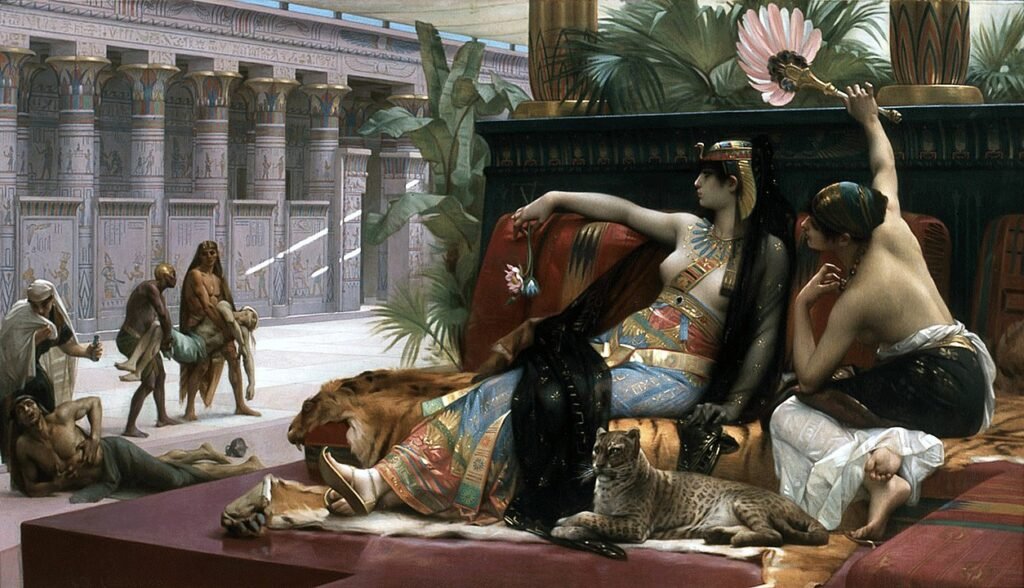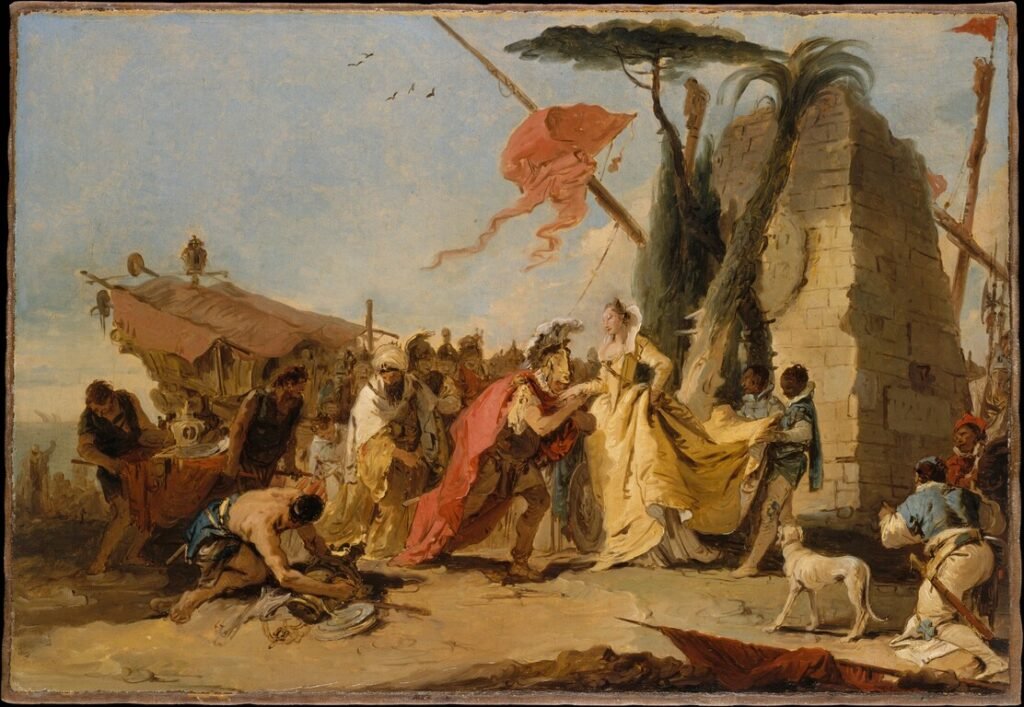Cleopatra, the renowned Queen of Egypt, has been the fancy of artists throughout history. From her captivating beauty to her powerful reign, Cleopatra’s allure has inspired countless artistic interpretations. In this article, we will explore the seven most iconic paintings of Cleopatra, each offering a unique glimpse into her legendary life. These masterpieces, created by acclaimed artists from various periods, capture the essence of Cleopatra’s enigmatic persona, her seductive charm, and her influential role in ancient history.
Caesar Placing Cleopatra Back on the Throne of Egypt

Artist: Pietro da Cortona
Year: 1637
Caesar Restoring Cleopatra to the Throne of Egypt is an oil-on-canvas masterpiece by the Italian Baroque artist Pietro da Cortona. Commissioned by Louis Phélypeaux, marquis de La Vrillière for his opulent Parisian hôtel particulier, this painting transports viewers to a theatrical setting adorned with Roman architectural grandeur.
At the heart of the composition, amidst the splendor, stands the emperor Julius Caesar, adorned in a regal red cloak and laurel crown. With open arms, he warmly welcomes Cleopatra, inviting her to ascend the throne, which bears a crown and scepter, symbolizing her rightful place as the ruler of Egypt. Meanwhile, a woman, brimming with resentment, descends the steps, departing from the scene. This woman is Arsinoe, Cleopatra’s sister, and rival, who was once recognized as the queen of Egypt by the people of Alexandria before her dethronement by Caesar.
Intriguingly, Cleopatra, although of Greek heritage, is portrayed as a fair-skinned European with flowing blonde hair. She emanates a gentle and submissive aura, juxtaposing the vibrant personalities of Caesar and Arsinoe. The narrative is further accentuated by a thoughtful color palette, where the prominent figures don brightly-hued garments, while Arsinoe is clad in subdued tones, emphasizing the power dynamics and the contrasting emotions at play.
The Banquet of Cleopatra

Artist: Giovanni Battista Tiepolo
Year: 1744
The Banquet of Cleopatra, an iconic painting completed by Giovanni Battista Tiepolo in 1744, transports viewers to a legendary historical event. Inspired by accounts from Pliny’s Natural History and Plutarch’s Lives, Tiepolo brings to life the extravagant feast hosted by Cleopatra for Marc Antony.
Central to the composition is Cleopatra herself, captivating and regal, as she performs a remarkable act. With a touch of decadence, she takes a precious pearl and delicately dissolves it into her wine. The painting captures the opulence and drama of the moment, showcasing Cleopatra’s extravagant gesture.
Set against a grand architectural backdrop, the banquet unfolds either in the open air or within a magnificent loggia. The sky is visible, adding a sense of expansiveness to the scene. A raised terrace envelops the back of the pictorial space, creating a sense of enclosure and adding depth to the composition.
Cleopatra Testing Poisons on Condemned Prisoners

Artist: Alexandre Cabanel
Year: 1887
Cleopatra Testing Poisons on Condemned Prisoners, painted in 1887 by Alexandre Cabanel, is a striking artwork housed in the Royal Museum of Fine Arts Antwerp. The painting depicts a chilling scene inspired by Mark Antony’s account in Plutarch’s Lives.
In the composition, Cleopatra, adorned in luxurious robes, reclines gracefully on a couch. Despite the gravity of the situation, she exudes an air of detachment and ease. Beside her rests a cheetah, adding an element of exoticism and power. The composition is divided into two distinct parts, symbolizing the stark contrast between opulence and brutality.
In the shaded “island” of comfort and beauty, Cleopatra and her entourage of graceful attendants are surrounded by lush fabrics and vibrant flowers. They observe the scene unfolding before them with lazy indifference. Meanwhile, under the relentless sun, a square in front of imposing columns becomes the stage for a grueling execution. Condemned prisoners, tormented by the effects of the poison, writhe in agony. Servants carry away the lifeless body of one victim while another suffers in great pain.
Cleopatra and Caesar

Artist: Jean-Léon Gérôme
Year: 1866
Completed in 1866 by the celebrated French Academic artist Jean-Léon Gérôme, Cleopatra and Caesar, also referred to as Cleopatra Before Caesar, is a captivating oil on canvas painting. The artwork portrays a pivotal moment in history, set in 47 BC, where Cleopatra boldly presents herself before Julius Caesar. The scene unfolds shortly after her servant, Apollodorus, has cleverly smuggled her into the palace concealed inside a rug.
The painting portrays Cleopatra, a mesmerizing and enigmatic figure, who commands attention with her regal presence. Standing before the powerful Julius Caesar, she exudes confidence and determination. The composition skillfully captures the tension and intrigue of their encounter, leaving viewers captivated by the unfolding drama.
The Meeting of Antony and Cleopatra

Artist: Giovanni Battista Tiepolo
Year: 1745–47
The Meeting of Antony and Cleopatra, created between 1745 and 1747 by Giovanni Battista Tiepolo, is a masterpiece housed within the former Yusupov country palace at Arkhangelskoye, near Moscow. This artwork portrays a pivotal moment in history.
In the painting, Marc Antony’s majestic galleon has arrived in Egypt, and upon beholding the unparalleled beauty of Queen Cleopatra, the Roman general humbly bows to kiss her hand. Antony’s ill-fated love for Cleopatra would ultimately lead him to betray Rome.
The composition is rich in symbolism, with black attendants and a turbaned figure representing foreign lands and cultures. Cleopatra, however, is depicted with European features and attire, blending influences from theater practices and seventeenth-century fashion.
The Death of Cleopatra

Artist: Juan Luna
Year: 1881
The Death of Cleopatra also referred to as Cleopatra, is a striking oil painting created in 1881 by the Filipino artist Juan Luna. This remarkable artwork is currently showcased at the Museo del Prado in Madrid, Spain. Luna drew inspiration from Plutarch’s account of Cleopatra’s life in his Parallel Lives series to compose this poignant scene.
The painting portrays Cleopatra in the moments following her demise. At the heart of the composition lies her lifeless body, gracefully resting on a bed adorned with a resplendent golden headboard. Luxurious bedsheets, intricately decorated with hieroglyphs, enfold her, while the footboard mirrors the opulence in its golden embellishments.
Cleopatra herself is adorned with magnificent jewels and garbed in regal attire befitting an Egyptian queen. Hovering above her body, a mysterious aura is created by wisps of smoke emanating from an incense-filled lamp nearby, symbolizing her passing. The painting evokes a sense of mystery, capturing the intrigue and allure surrounding the queen’s final moments.
Cleopatra and the Peasant

Artist: Eugène Delacroix
Year: 1838
Created in 1838 by the renowned French artist Eugène Delacroix, Cleopatra and the Peasant is an alluring painting that captures a moment of interaction between the iconic queen and a humble peasant. In this composition, Cleopatra is depicted seated in a chair, attentively listening to the peasant as he presents a basket of items to her.
Delacroix’s artistic approach draws the viewers’ gaze to the central figures by keeping the background relatively sparse. This deliberate choice ensures that the focus remains on the captivating interaction between Cleopatra and the peasant.
